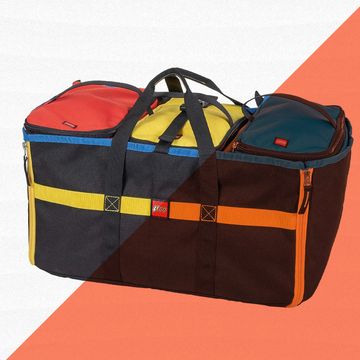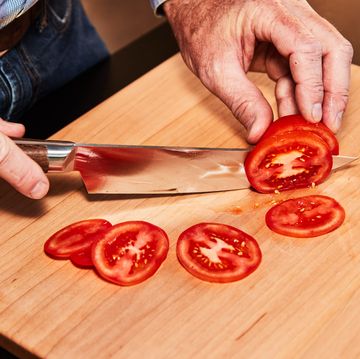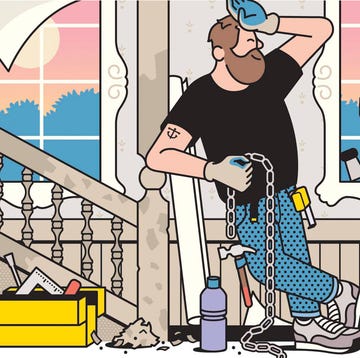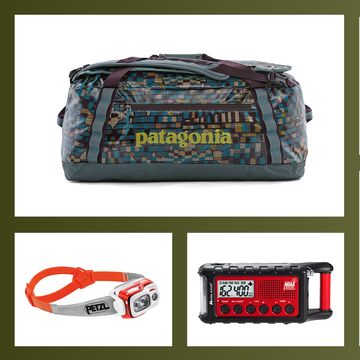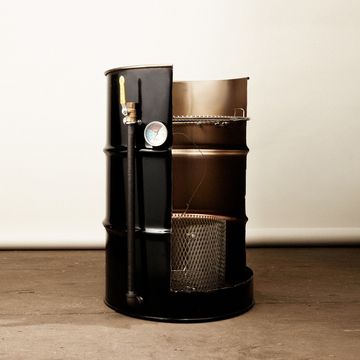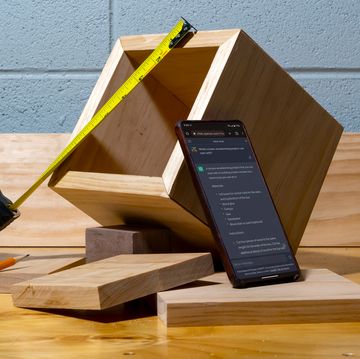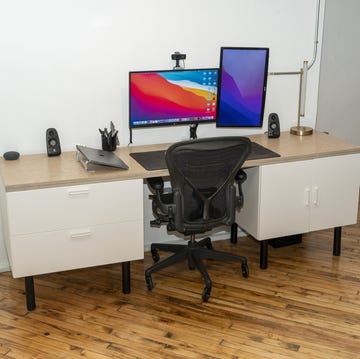1Before You Start
 Media Platforms Design Team
Media Platforms Design TeamFirst, practice handling the gun without actually welding. Rest its barrel in one hand, and support that hand on the table. The other hand operates the gun's trigger. Stand in a comfortable position and move the gun steadily over the work surface. Adjust your posture and gun movement so that they feel natural.
Attach the work lead to the workpiece, and hold the gun so the wire meets the weld surface at about a 30-degree angle. Touch the wire very lightly to the surface, squeeze the trigger, and gently pull the gun toward you to make your first test weld. The wire should melt off into the weld puddle at an even rate and make a steady crackling noise as you go. Adjust the welder settings if needed.
2Prepare the Metal
 Media Platforms Design Team
Media Platforms Design TeamMark a line with a carbide scribe or woodworker's awl, and cut with a metal-cutting chop saw or a hacksaw. For a strong weld, clean the metal with a degreaser.
3Prepare the Metal (Cont.)
 Media Platforms Design Team
Media Platforms Design TeamNext, grind or file a slight bevel along the edges you're welding. This ensures the weld penetrates as deeply as possible and countersinks it so you can grind it flush. Don't overdo it or you'll burn through the metal when you weld.
Advertisement - Continue Reading Below
4Position the Pieces
 Media Platforms Design Team
Media Platforms Design TeamWhen building a project like our C table, you'll need to form exact 90-degree angles. Clamp the mitered surfaces together, leaving enough room to put down a tack weld. The pieces should lie flat and fit neatly without a metal burr interfering.
Check the assembly's position with a square. Use a carpenter's aluminum triangle square on the inside of the joint, or a steel carpenter's square on the outside.
5Tack Weld
 Media Platforms Design Team
Media Platforms Design TeamTack the pieces together at a couple of places along each joint. Check again for square corners; if anything shifts and puts the assembly out of square, grind away the tack weld, reposition the parts, and try again.
6Finish Weld
 Media Platforms Design Team
Media Platforms Design TeamAfter you've tacked everything into place, lay down your final weld beads. As enjoyable as it is to create nice, smooth welds, resist the temptation to overdo it. The more metal you deposit, the more you'll need to grind off.
Advertisement - Continue Reading Below
7Post-Weld Cleanup
 Media Platforms Design Team
Media Platforms Design TeamChip off the slag with a welding hammer, and then use a 36-grit grinding wheel to knock the beads down to the surrounding metal. To ensure a flat, flush surface, move the grinder along the weld, not across it. Remove any marks with a 60-grit zirconia flap disc.
Finishing Tip
Prime and paint the steel, buff some clear wax over it, or spray on a coating of clear acrylic. But do it sooner rather than later. You don't want a layer of rust to form.
8Make This Metal C Table
 Media Platforms Design Team
Media Platforms Design TeamOur C table is an elegant reduction of furniture to an industrial form. Two 16-inch-square frames are joined by two 15-inch-long uprights. Use the structure to support a top of wood, stone, glass, or metal.
It's an ideal project for a first-time welder. All 10 pieces of steel are cut from 1-inch-square steel tubing with a 1/16-inch wall thickness. The pieces for the top and bottom frames are joined with 45-degree miters. The two uprights meet the frames with butt joints. And the welding couldn't be simpler: Flux-cored arc welding with a low amperage setting and a slow wire speed is about as easy and forgiving a process as you can learn.
Advertisement - Continue Reading Below
Advertisement - Continue Reading Below
Advertisement - Continue Reading Below



